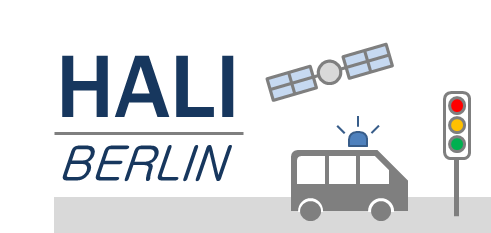Research Cooperative Systems
The department is pioneering new autonomous mobility solutions by researching, designing, and demonstrating connection, automation, cooperation, and coordination for vehicles, system networks, and us humans.
The HALI_Berlin project is a research and demonstration project funded as part of the BMDV's National Programme for the Promotion of GALILEO-PRS. The term "HALI" is derived from the Finnish abbreviation "HälytysAjoneuvojen LIikennevaloetuudet", which translates as "traffic light control for emergency vehicles". The main objective of the HALI_Berlin project is to test and demonstrate the GALILEO-PRS navigation service in an application for authorities and organisations with security tasks. Specifically, emergency vehicles of the Berlin police and fire brigade are to locate each other quickly, reliably and without interference in a challenging inner-city test area in Berlin-Moabit. This reliable position information will be used to adapt the control of traffic lights. In this way, GALILEO-PRS supports the emergency services in travelling quickly, safely and without delay to the scene of an emergency.
Systems and technical solutions already exist that are designed to get emergency services to their deployment location as quickly as possible (compliance with response times) and safely (no crossing of red signals). However, these systems have significant disadvantages: The positioning of the emergency vehicles required for priority is often not sufficiently precise, especially in densely built-up inner city areas, due to multipath propagation and sudden shadowing of the satellite signals. The position signals can also be disturbed (jamming) or falsified (spoofing) by manipulative interference. This means that the availability required by the emergency services is not always guaranteed.
In the area of traffic light control, there is also the problem that priority is often limited to the immediate next junction instead of being available flexibly along an emergency route and using a lead time to reduce congestion at a junction. In addition, all approaches to a junction that are not used by the emergency vehicle are often blocked, even though there may be no conflict with the emergency vehicle. This results in additional congestion and waiting times for general traffic.
The aim of the HALI_Berlin research project is to address these existing limitations and to demonstrate the priority of emergency vehicles along dynamic routes on the basis of the European satellite navigation system GALILEO and the PRS service (Public Regulated Service) under real conditions in a complex inner-city test area.
GALILEO-PRS is a cryptographically protected navigation service that has been specially defined for users with sovereign tasks such as authorities and organisations with security tasks. The PRS signal design and the encryption used ensure a very high level of protection against interference and falsification. In this way, GALILEO PRS enables a range of safety-critical applications that cannot be realised in this form with other navigation services. In order to fulfil the requirements for real operation, the existing PROOF miniPRS receivers were further developed in the HALI_Berlin project with regard to reliability and robustness against interference as well as positioning accuracy. As the previous development status was only aimed at processing the Open Service (OS) and the PRS signal under laboratory conditions with ideal reception conditions, the receivers were upgraded for use in vehicles and modified in terms of size and energy consumption. Following their safety certification, the receivers developed in this way were integrated into selected vehicles of the Berlin police and fire brigade.
A total of five emergency vehicles were equipped with the extended GALILEO receivers in order to be able to experience priority at traffic lights as part of the test operation. These are three vehicles of the Berlin police and two vehicles of the Berlin fire brigade.
Due to the location of the police and fire stations, these vehicles are regularly on the road in the Berlin-Moabit test area in order to get to neighbouring locations. The selected test area is characterised by dense, inner-city development with many urban canyons and a high volume of traffic with frequent traffic jams.
In addition to the emergency vehicles, eight traffic lights were equipped with special communication technology so that the vehicles "report" to these traffic lights when they are approaching. These then automatically switch to green so that the emergency vehicle can drive through the junction at a higher speed. The coordination of an emergency route across several traffic lights is handled by a backend in which the data from the emergency vehicles (e.g. position and speed) is linked with the information on the location and traffic situation. This central HALI server can use the combined data to adjust the switching of the nearest traffic lights with pinpoint accuracy, thereby reducing journey times and increasing safety.
Project title:
HALI_Berlin
Duration:
07/2017 to 12/2023
Project volume:
€ 1.680.000
Contracting authority:
Federal Ministry for Digital and Transport (BMDV)
Project participants:
DLR Institute of Transportation Systems
Fraunhofer Institute for Integrated Circuits
Berlin Senate Department for Urban Mobility, Transport, Climate Action and the Environment
Berliner Senatsverwaltung für Inneres und Sport
Police Berlin
Fire brigade Berlin
Siemens AG
Airbus DS GmbH
IABG GmbH
Alarm Dispatcher Systems GmbH


